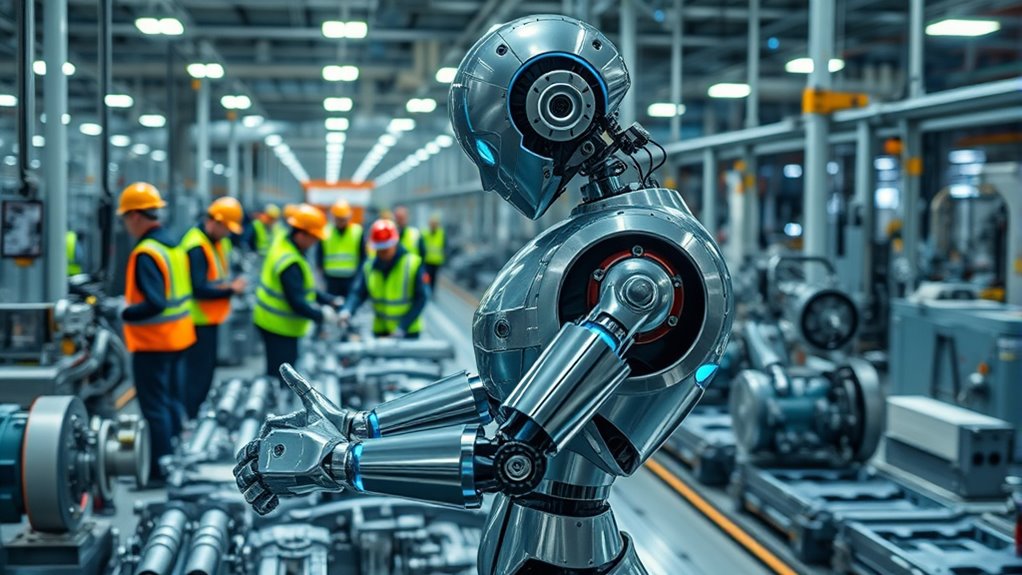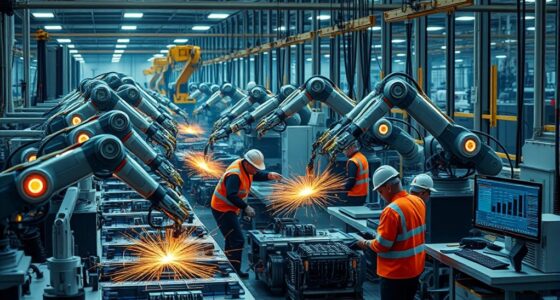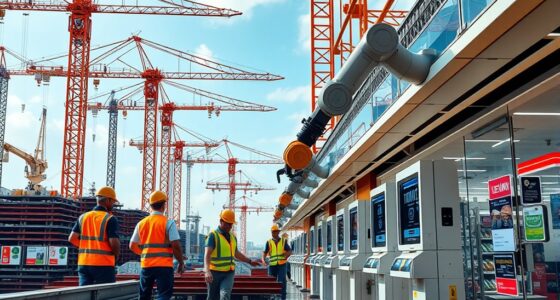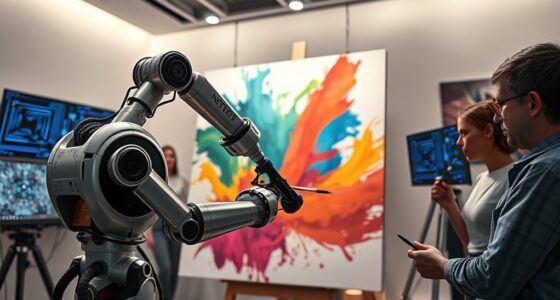In manufacturing, robots considerably boost productivity, often outperforming humans in repetitive tasks and high-precision work. Companies that adopt automation see gains of over 250% in productivity, especially in sectors like automotive and electronics. While robots excel in speed and efficiency, humans bring critical thinking and flexibility. The race isn’t about one versus the other — it’s about how best to combine both for ideal results. Keep exploring to discover how this collaboration shapes the future of manufacturing.
Key Takeaways
- Robots significantly boost productivity, with some sectors experiencing up to 250% increases after automation.
- Higher robot density correlates with greater productivity gains, often surpassing human-only processes.
- Humans excel in complex, strategic tasks, while robots handle repetitive, high-volume operations efficiently.
- The most productive manufacturing systems integrate both robots and humans, leveraging their complementary strengths.
- Ultimately, the “winner” depends on strategic implementation; integrated human-robot collaboration drives optimal productivity.

In today’s manufacturing landscape, robots are transforming how factories operate, often surpassing human workers in productivity and efficiency. You might have seen this firsthand in factories in China, where replacing 90% of the human workforce with robots led to a staggering 250% increase in productivity. That’s more than double what manual labor could achieve. Every 1% increase in industrial robot density correlates with a 0.8% boost in productivity, making automation a clear driver of growth across sectors. For example, industries like agriculture, mining, and education, which tend to adopt technology more slowly, still enjoy a 5.1% productivity boost through robotic automation. South Korea, forecasted to gain about 6% in cost competitiveness over the U.S. by 2025, is leveraging robotics to stay ahead in manufacturing. Similarly, the UK could see a 21% increase in manufacturing gross value added over the next decade if it accelerates its robot adoption.
You’ll find that industry-specific impacts vary, with automotive, electronics, chemicals, and food and beverage manufacturing reaping the highest productivity gains. These sectors benefit most from robots handling repetitive and precise tasks. Notably, lower automation sectors like textiles and construction experience steeper productivity improvements once they adopt robotic solutions. Metal and machine-building industries, which rely heavily on repetitive work, gain considerably from robotic integration. Agricultural and forestry sectors also see notable efficiency gains, as robots enable faster planting, harvesting, and resource management. Utilities are driving productivity growth through robotic process automation, streamlining operations and reducing downtime. According to recent studies, nearly half of US jobs are at risk of automation within the next 20 years, indicating a profound shift in employment patterns. This trend underscores the importance of understanding the risks associated with gold investments, as economic shifts can influence investment strategies.
Despite the gains, employment impacts are complex. In some factories, like the Dongguan plant, 90% of the human workforce was cut, leaving only 60 employees for oversight and monitoring. But most manufacturers—around 57%—report that robots augment human roles rather than replace them completely. Many facilities now operate with a high ratio of robots to humans—up to 10:1—focusing humans on strategic and complex tasks. Still, safety and operational challenges persist. Nuisance faults cause production shutdowns every 1-2 hours in some cases, and workers often enter robotic workcells hourly, raising safety concerns. While many are satisfied with current safety protocols, limitations in workflow flexibility and space constraints remain issues.
You need to understand that automation is reshaping the manufacturing landscape, driving productivity and competitiveness while altering employment patterns. Companies that strategically implement robots and focus on human-robot collaboration stand to benefit most, balancing efficiency gains with workforce safety and adaptability. As automation continues to evolve, the race between robots and humans is not about replacing but rather transforming manufacturing into a smarter, more efficient enterprise.
Frequently Asked Questions
How Do Robots Impact Employee Job Satisfaction?
You might feel a mix of excitement and anxiety about robots impacting your job satisfaction. Robots reduce repetitive tasks, giving you the chance to focus on more meaningful work, which can boost morale. However, rapid automation and job insecurity can cause stress, regional disparities, and feelings of obsolescence. Your experience depends on how well your industry supports upskilling and adapts to technological changes, influencing your overall satisfaction.
What Are the Long-Term Economic Effects of Automation?
While automation brings short-term cost savings, its long-term economic effects shape a complex landscape. You’ll see increased productivity, boosting GDP and creating new high-skill jobs, but also face workforce reskilling challenges and industry shifts. Capital investment rises, altering traditional cost structures, and price reductions benefit consumers. Ultimately, automation drives sustainable growth, but only if you adapt by fostering innovation and cultivating the skills needed for this evolving economic environment.
Can Robots Adapt to Unexpected Manufacturing Issues?
You see, robots can adapt to unexpected manufacturing issues thanks to AI-powered real-time data analysis and machine learning. They detect problems early, adjust workflows automatically, and learn from experience to handle new challenges. Cobots, with advanced sensors and vision systems, safely operate in dynamic settings, minimizing downtime. This adaptability boosts efficiency, allowing you to respond quickly to disruptions and maintain productivity in unpredictable production environments.
How Do Maintenance Costs Compare Between Robots and Humans?
You see, maintenance costs for robots are typically around $10,000 annually, mainly for operations and repairs, while human labor involves ongoing wages, benefits, and recruitment expenses. Robots require a significant upfront investment but lower ongoing costs, especially with preventative maintenance that can reduce failures. Humans, however, incur continuous costs, including hidden overheads like healthcare and training. Over time, these differences impact overall operational expenses and ROI.
What Ethical Considerations Arise With Increased Automation?
Have you thought about the ethical issues that come with more automation? As you increase reliance on AI, you face bias risks, opacity in decision-making, and potential loss of worker autonomy. Surveillance and data privacy concerns also grow, possibly compromising health, safety, and privacy rights. Are you ensuring fairness, transparency, and social responsibility? Addressing these considerations is key to sustainable, ethical automation that benefits both businesses and workers.
Conclusion
In the end, you see, it’s not about robots or humans winning the race, but how you blend their strengths. Robots bring precision and speed, like a well-oiled machine from the Industrial Revolution, while humans offer creativity and adaptability. As you embrace this new era, remember that the best results come when both work together—like a modern-day Renaissance, forging a future where productivity soars without losing the human touch.









